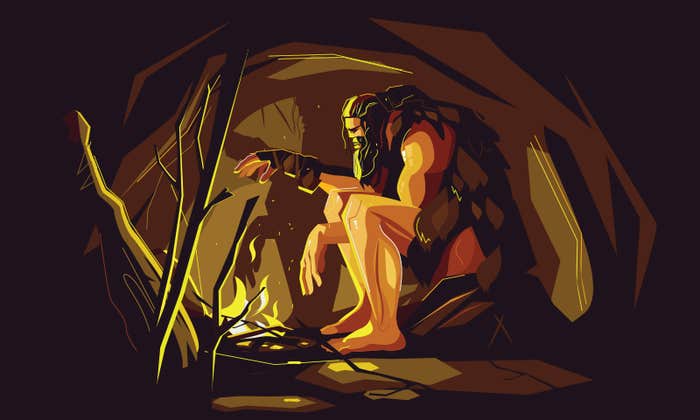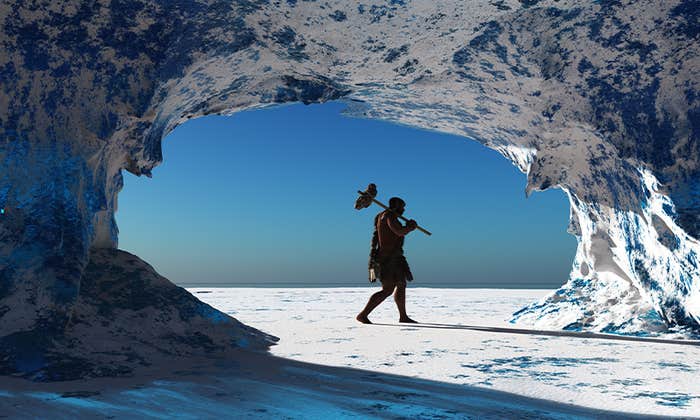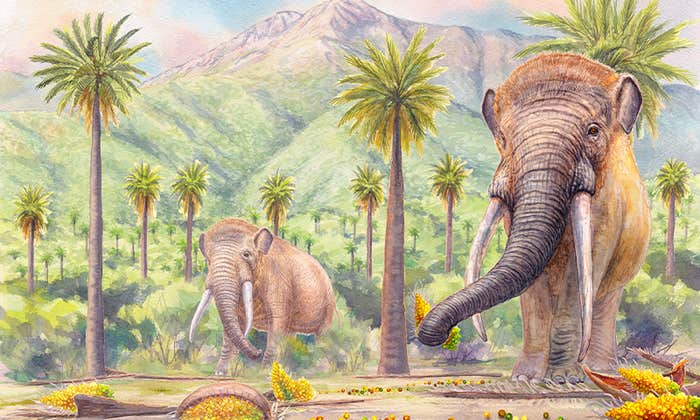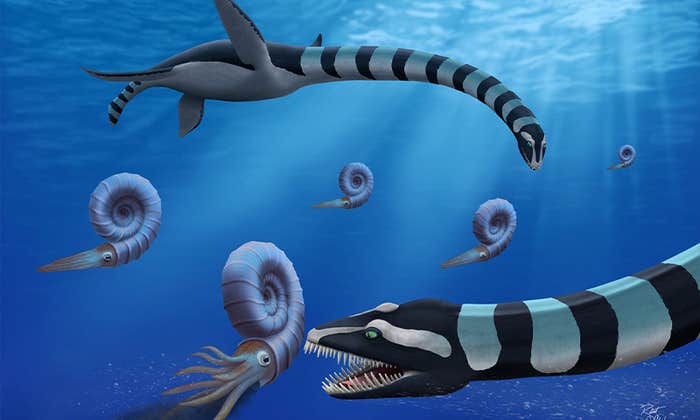People have always known of dinosaurs, though they have called them by many names. Old legends that place Western dragons in caves or beneath the earth may have originated with fossils. The plumed serpent, prominent in mythologies of Mexico and Latin America, is often a creator of life. The Rainbow Serpent of Aboriginal tales was present at the beginning of time, and helped prepare the landscapes for human beings and other animals. The Asian dragon, which combines features of many animals, symbolizes primordial energy and is the bringer of rain. These figures resemble our reconstructions of dinosaurs in appearance, and accounts place them in worlds that existed before humankind. The major reason for this similarity might be that human imagination works in much the same way as evolution. Both constantly recycle familiar forms such as wings, claws, crests, fangs, and scales, which may repeatedly vanish and then reappear through convergence. The figure of Tyrannosaurus rex suggests a kangaroo, while pterosaurs resemble bats, but the similarities are not due to common ancestry.
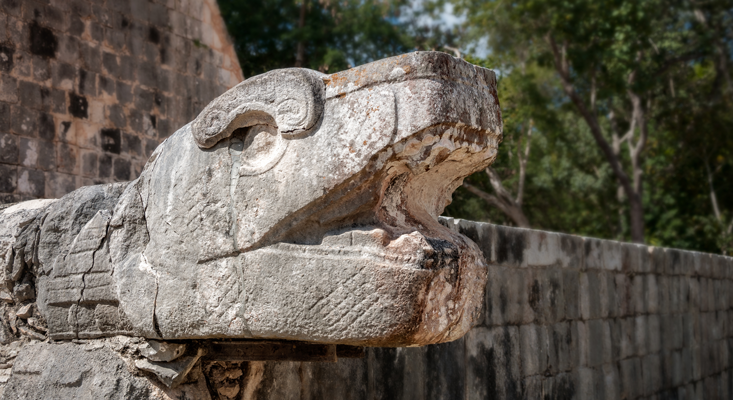
Children, who are just learning the basic expectations of their society, are in ways outside of culture. Their attraction to dinosaurs suggests that the giant creatures appeal to something innate, or at least very elemental, in the human psyche. One highly speculative explanation is that this is a genetic legacy, going back to the days when early humans faced gigantic, prehistoric lizards such as the megalania or perhaps even the days when our remote mammalian ancestors had to contend with dinosaurs themselves. A simpler explanation is that images of dinosaurs convey the excitement of danger while posing no actual threat. It could also be that dinosaurs, from a child’s point of view, seem like grown-ups, since they are both very old and very big.
By inspiring fantasy, dinosaurs alleviate a child’s feelings of helplessness. Gail Melson has described this vividly:
A slight, shy, 8-year-old boy I know hurries home after school each day to go back to the age when dinosaurs roamed the Earth. A walking encyclopedia of dinosaur lore, he never tires of playing out battles between brontosaurus and tyrannosaurus, using his six-inch high replicas. Unlike the power of adults or bigger, more assertive peers, dinosaur power is, literally, under his thumb.
And why do most children leave that fascination behind well before reaching adulthood?
Adults often feel almost as powerless as children. They find relief in such activities as blasting aliens in video games, as well as other pastimes that are far less innocuous, but seldom in playing with dinosaurs. But maybe grown-ups don’t really get over the dinosaur phase? It could be that they simply relive it vicariously through children. We have traditionally thought of dinosaurs as tragic, since (with the exception, we now know, of avians) they became extinct, yet were once enormously large and powerful. This corresponds to the combination of ability to dominate and extreme vulnerability, which are both essential aspects of the way we think of humankind.
At any rate, that little boy is very far from being alone. At the American Museum of Natural History in New York, which I visit regularly, there is a shop in which almost an entire floor, one-third of the space, is devoted to dinosaur paraphernalia, and most of the items there have no more than a very oblique connection with science. There are shelves upon shelves of plush dinosaur toys, many of which are enormous. There are many picture books about dinosaurs, for children that are just learning to read, mechanical dinosaurs, and countless accessories sporting pictures of dinosaurs.
Human imagination works in much the same way as evolution. Both constantly recycle familiar forms such as wings, claws, crests, fangs, and scales.
That 8-year-old described by Melson could, in many ways, have been me, though paleontology was not nearly so heavily commercialized in my childhood as it is today. Dinosaurs were, like presidents and teachers, accorded a lot of dignity. But in Chicago’s Field Museum the reconstructed skeleton of an apatosaurus stood beneath the dome of a great hall. A huge bone was placed on a small pedestal in front of the skeleton, which people were invited to touch. When I did so, the bone seemed very hard and cold, almost metallic, but that only accented the metabolic warmth of the creature it had once helped to support. I was always a bit of a loner, as well as a romantic. Looking back, I suppose the world of dinosaurs was a sort of refuge for me, mostly from adults who thought they understood me yet never could.
There is something comforting for people of all ages about the way at least some kids in every generation go through a “dinosaur phase,” despite all the changes that society has experienced in the last century and a half. Dinosaurs appeal to a Victorian sort of “childhood wonder,” as well as reassuring us that our childhood experiences are part of an eternal condition. The phenomenon is especially remarkable because it so often seems to first emerge spontaneously in children, with very little adult encouragement. Yet perhaps dinosaurs, after all, are no more immortal than human beings. The ways we imagine them, at least, have been subject to constant change since their initial discovery in the early 19th century.
Maybe, after my childhood encounter with dinosaur bones, every subsequent experience of them could not be without a trace of disappointment. For me, as a child, it was the gateway to a world that would be without social pressures and demands. “To be a dinosaur,” a phrase that I used in a late adolescent poem, meant simply to be myself. It turns out that dinosaurs, or at least their bones, have been, since their discovery, deeply implicated in the worlds of commerce and power politics. But my childhood experiences suggest to me that, if all the hype could be finally stripped away, something wonderful might remain.
As Tom Rea has observed, since the early 20th century people have thought of museums of natural history as “temples to science, with the dinosaur exhibit as their central shrine.” Museums, especially those of that era, were modeled on old temples or churches, with their high ceilings, domes, and elaborate reliefs. They were, like churches, guardians of esoteric knowledge.
This resemblance of museums to cathedrals is not simply a matter of accidental associations. It reflects the ideas of natural theology, which was a driving force behind early science and, though challenged by evolutionary theory, remains very influential today. This holds that the order of the natural world is proof of a conscious plan and, thereby, the existence of God. To study this order is to reveal part of the divine plan, an activity that should inspire reverence and awe. Religion linked the scientific communities with a larger public. In the words of Martin Rudwick:
The popularization of science was formerly treated as a wholly one-way process … by which scientific pundits translated … their esoteric findings into more accessible language, with inevitable loss or distortion of content on the way. More recently, however, the process has come to be seen as being initiated as much from the ‘popular’ end as from the scientific.
For one thing, science is dependent on sources of funding, which are heavily influenced by public perception. This, in turn, does much to determine the direction of research. Popularizations are also instrumental in recruiting young people to scientific vocations. In addition, scientists, whether they are conscious of it or not, cannot help but be influenced by the constant proliferation of images relating to their field in the popular media. In their capacities as employees of museums, companies, and even universities, many scientists must constantly engage with the public, as representatives of their profession.
Furthermore, the way that scientists communicate with one another is now, inevitably, in large part through the popular media. Though professional journals continue to be important, they have always been slow and cumbersome. New discoveries are likely to be reported substantially before they can be written up in a formal way and subjected to peer review. The knowledge of a layperson may not compare in depth with that of a professional paleontologist, but it can be almost as up to date. Accordingly, we will be better able to understand the significance of dinosaurs to the contemporary world if we do not think of science as monolithic, much less as a “realm apart.” It would be more accurate to regard “science” as a vast area of human endeavor, requiring not only researchers but philosophers, web designers, artists, teachers, journalists, museum professionals, and so on. This contradicts the romantic image of the lone researcher engaged in a personal struggle for the truth, which will ultimately triumph over ignorance and superstition; an impression that is anachronistic at best. Today, most scientific papers have at least three authors, often many more. The connection to popular culture also limits the claim of science to objective truth, since it is intimately dependent on so many intangible, subjective, psychological, and otherwise contingent factors.
Discoveries in physics are now almost impossible to visualize, even for researchers, but those in paleontology are easily translated, with just a little imagination, into very colorful images. Within a very short time of their discovery in the late 18th and early 19th centuries, people had an emotional relationship with dinosaurs that was as complex, ambivalent, multifaceted, and in some ways intimate as our bond with just about any living animal, including the dog and the cat. It was a relationship largely mediated by fantasy, like the relationship of the public to celebrities, yet no less authentic on that account. Dinosaurs have been featured in exhibitions, theme parks, novels, toys, movies, comics, logos, and all the other paraphernalia of popular culture.
Most popular representations of dinosaurs ignore even the limits imposed by paleontology.
More overtly scientific activities are also pervaded by showmanship, though here it takes subtler forms. Early discoverers of dinosaurs such as Gideon Mantell greatly exaggerated their size, appealing to the public’s taste for both grandeur and novelty. In the late 19th and early 20th centuries the search for huge bones became an arena of competition, for not only explorers but the industrialists and governments that backed them, and was, essentially, a form of trophy hunting.
Since, even with highly sophisticated tools, it is possible to infer only so much information from bones and related objects, those who wish to reconstruct the appearance and habits of dinosaurs have plenty of scope for imagination. Most popular representations of dinosaurs ignore even the limits imposed by paleontology, while often incorporating a few recent discoveries in order to appear up to date. Our images of dinosaurs owe at least as much to the dragons and demons of medieval art—which, in turn, go back to archaic deities—as they do to fossils. These serpents were often associated with anachronistic beliefs or remote times, so dragon-slayers such as St George or Beowulf, like paleontologists of today, came across as promoters of modernity.
We are not descended from dinosaurs, and our ancestors did not interact with them, outside of comic books and B-movies. But, precisely for those reasons, it is easier to consider their world as a mirror of the human condition.
The fact that dinosaurs became extinct has made their story resonate with the apocalyptic traditions of the Zoroastrian, Judaic, Christian, and Islamic religions. Their size and power suggest empires and battles on an epic scale, perhaps even a sort of Armageddon. Even the current view that some dinosaurs survived to become birds suggests a sort of angelic elect that will be saved. But our apocalyptic fears have been secularized, and the meaning of dinosaurs has changed with them. In the late 19th and early 20th centuries, dinosaurs were often used to represent big business, though their eventual demise could seem like a proletarian revolution. Later, their apocalyptic associations might be used to express terror of a nuclear holocaust or of ecological collapse. In addition to the elemental appeal of great size and antiquity, the reason for the popularity of dinosaurs is that their symbolism is flexible enough to accommodate a vast range of meanings. They have been used to comment on human violence, innocence, wealth, industrialization, failure, modernity, tragedy, extinction, and far more.
But none of these things really has much to do with dinosaurs in the end. We are simply imposing our own meanings on their endlessly mysterious lives. I will not preach against this, for exploiting other creatures as symbols is simply what human beings do, and I am no more exempt than anyone else. But, when we speak of dinosaurs essentially as cultural artifacts, we should remember, from time to time, that they were once, and still are, vastly more.
Boria Sax is an American author and lecturer and a teacher at Mercy College. He is the author of Imaginary Animals, the Wondrous and the Human and Animals in the Third Reich: Pets, Scapegoats, and the Holocaust, among other books.
Reprinted with permission from Dinomania: Why We Love, Fear and Are Utterly Enchanted by Dinosaurs by Boria Sax, published by Reaktion Books Ltd. Copyright © 2018 by Boria Sax. All rights reserved.
Lead image: ra2studio / Shutterstock





















